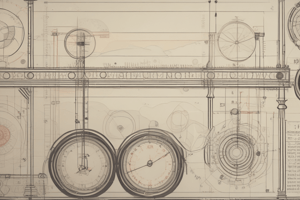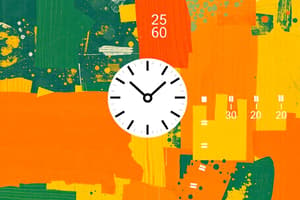Podcast
Questions and Answers
What is the instrument used to measure mass in the metric system?
What is the instrument used to measure mass in the metric system?
- Microscope slide
- Thermometer
- Balance (correct)
- Ruler
Which prefix indicates a thousandth in the metric system?
Which prefix indicates a thousandth in the metric system?
- Deci-
- Centi-
- Milli- (correct)
- Kilo-
What is the correct unit for measuring temperature in the metric system?
What is the correct unit for measuring temperature in the metric system?
- Meters
- Fahrenheit
- Celsius (correct)
- Pounds
Which microscope type is more suitable for viewing whole organisms or larger specimens?
Which microscope type is more suitable for viewing whole organisms or larger specimens?
What is the formula to calculate total magnification of a compound light microscope?
What is the formula to calculate total magnification of a compound light microscope?
Which unit would you use to express a volume of 0.001 liters?
Which unit would you use to express a volume of 0.001 liters?
What is the term used to describe the process of breaking down complex molecules by the addition of water?
What is the term used to describe the process of breaking down complex molecules by the addition of water?
What is the term for a substance or mixture used in a chemical analysis to detect, measure, or produce other substances?
What is the term for a substance or mixture used in a chemical analysis to detect, measure, or produce other substances?
Which type of control aids in verifying the accuracy and reliability of an experiment by introducing an element that is expected to produce a positive result?
Which type of control aids in verifying the accuracy and reliability of an experiment by introducing an element that is expected to produce a positive result?
What characteristic defines a cell as eukaryotic rather than prokaryotic?
What characteristic defines a cell as eukaryotic rather than prokaryotic?
Which term describes the property of having both hydrophilic and hydrophobic regions in a molecule?
Which term describes the property of having both hydrophilic and hydrophobic regions in a molecule?
Why is it important to have a negative control in an experiment?
Why is it important to have a negative control in an experiment?
Flashcards are hidden until you start studying
Study Notes
Biological Molecules
- Reagent: a substance used in a chemical reaction to detect or measure a specific substance
- Control: a standard against which other results are compared
- Positive control: a sample that is known to contain the substance being tested
- Negative control: a sample that is known not to contain the substance being tested
- Unknown: a sample whose composition is unknown
- Hydrolysis: a reaction in which a molecule is broken down into smaller molecules using water
- Dehydration synthesis: a reaction in which two molecules are combined to form a new molecule, releasing water in the process
- Carbohydrates: biomolecules that provide energy, e.g., sugars, starches, and fibers
- Lipids: biomolecules that provide energy and structure, e.g., fats, oils, and waxes
- Proteins: biomolecules that perform various cell functions, e.g., enzymes, hormones, and structural proteins
The Cell
- Structures/organelles found in all cells: cell membrane, cytoplasm, and genetic material
- Eukaryotic cells: have a true nucleus, found in plants, animals, fungi, and protists
- Prokaryotic cells: lack a true nucleus, found in bacteria and archaea
- Plant cell features: cell wall, chloroplasts, and vacuoles
- Animal cell features: no cell wall, no chloroplasts, and smaller vacuoles
- Lactobacillus: a type of bacteria
- Oscillatoria: a type of cyanobacteria
- Gloeocapsa: a type of cyanobacteria
- Amoeba: a type of protozoan
- Paramecium: a type of protozoan
- Euglena: a type of protozoan
- Penicillium: a type of fungus
- Modes of movement: Amoeba (amoeboid movement), Paramecium (cilia), and Euglena (flagella)
Cell Membrane
- Fluid mosaic model: a model of the cell membrane as a fluid phospholipid bilayer with embedded proteins
- Selectively permeable: allowing certain substances to pass through while keeping others out
- Amphipathic: having both hydrophilic (water-loving) and hydrophobic (water-fearing) regions
- Cell membrane components: phospholipids, proteins, and cholesterol
- Hydrophilic and hydrophobic components: hydrophilic heads and hydrophobic tails of phospholipids
- Cell membrane bilayer: two layers of phospholipids with hydrophilic heads facing outwards and hydrophobic tails facing inwards
The Metric System
- Basic units of measurement: gram (mass), meter (length), liter (liquid volume), and Celsius (temperature)
- Instruments used: balance (mass), ruler (length), graduated cylinder (liquid volume), and thermometer (temperature)
- Prefixes: centi- (100), milli- (0.001), and kilo- (1000)
- Conversion between units: using conversion factors
- Calculations: area, density, and volume using displacement method
The Microscope
- Parts of the microscope: objective lenses, eyepiece, stage, and focus knob
- Microscope handling: carrying, focusing, and adjusting the stage
- Magnification and resolution: magnification = objective lens x eyepiece, resolution = minimum distance between two distinguishable points
- Brightness changes: increasing objective lens changes brightness
- Wet mount procedure: placing a specimen on a slide with a drop of water and a coverslip
- Comparison of compound light microscope and dissecting microscope: advantages and disadvantages of each
- Types of microscopes: compound light microscope (for detail), dissecting microscope (for overview)
- Abbreviations: w.m. (wet mount), c.s. (cross-section), t.s. (transverse section), and l.s. (longitudinal section)
Studying That Suits You
Use AI to generate personalized quizzes and flashcards to suit your learning preferences.





